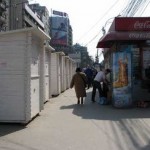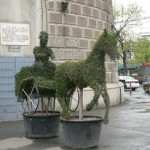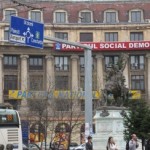Subject to brutal or useless gestures, the public space for the Romanians becomes worthless, confusing, ridiculous. The image of the places that represent us or where we meet, where we should have the chance to create community, must be improved. The quality of the urban space is a fundamental component of our life’s quality. We comment and criticize these operations because the non-public space resulting from indifference creates non-citizens, inhabitants of the non-urbanity.
1 The white stalls you see were set up on the pavement along the Magheru Avenue before March 1st, to be used for the huckster sale of the March 1st trinkets. There is a sensation of huge Water Closets, breathing a rural air not at all in concordance with the art deco buildings or the modernism of the 30s. The replacement of the small folding huckster’s stall with these pachyderms has only resulted into an expensive and hard operation, taking up the pedestrians’ and the buyers’ space. Inversely proportional to the frenzy they were set up with their dismantling was more than a month behind time, during which period they were closed. But of course, on the pavement they do not bother anyone.
2 Unlike the piano player in front of the Athenaeum or the dolphins on the Unirea fountains made up of small leaves interlaced on wire, we do not understand the significance of the man with a cart placed near the Fire Turret. The illustration of the architectural themes (dolphin for the water in the fountains pr the piano player for the Athenaeum) are gestures of an extremely touching cultural innocence, the only one allowing to bring together the dystrophic characters, the plastic flower pots and the city’s symbol-buildings. Art in the public space made progresses in other countries as well as medicine.
3 Probably one of the most representative and popular statues of Bucharest (Mihai Viteazu at the University) coexists with this traffic sign. I mean that it makes it inappropriate. Because the robustness and slenderness of the iron and the indications it gives to the traffic participants symbolize the modern world, the motorway, the speed, the future. How is it possible for such a visionary object to stand next to an obsolete monument? What kind of authorization does it have from the Ministry of Culture? The institution that manages these traffic signs and that failed to see the damages it brought by this gesture is kindly asked to consult architects, urban planners and the monument committee in the future. It is not difficult.
4 There is no doubt: IT IS SECTOR 5! IT REALLY IS! Equivalent to a shout through its size and loud colours, it is a typical nonsense for our public space. The elaborated emblem out of three pieces of iron and one of plastic manages to cancel the sobriety of the impressive square of the Military Club and helps us improve our knowledge of Urban Political-Administrative Geography. What is the information that we are in Sector 5 good for and why is it necessary to say it so loud, visually polluting a historical building? Nothing, obviously. Nevertheless, I do not recall having seen a decent tourist info-pointanywhere in the city.
Translation: Fides






